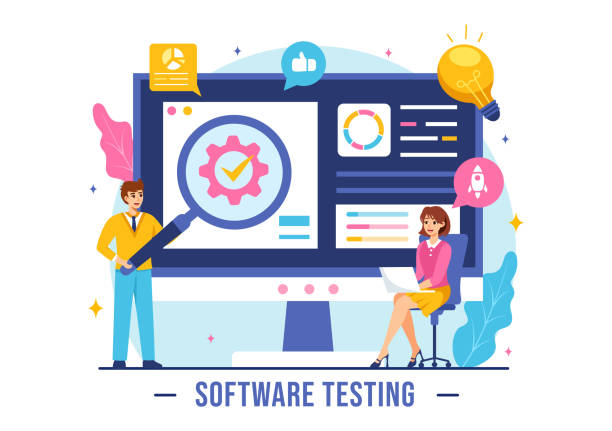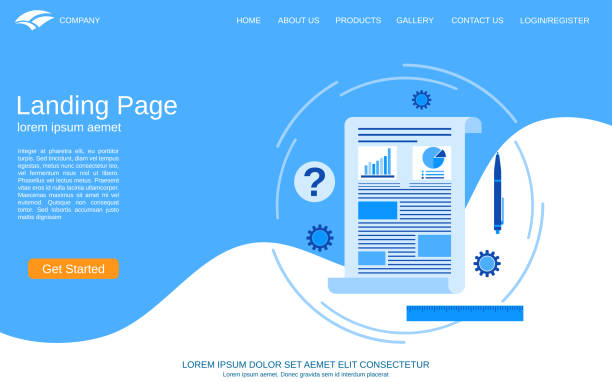1. Defining Responsive Web Design and Its Importance in the Digital Age

In today’s world, where users access the internet from various devices such as mobile phones, tablets, laptops, and even smart TVs, responsive web design is no longer a luxury option, but an undeniable necessity.
This approach enables your website to provide the best user experience regardless of screen size or device type.
Suppose a user visits your website on their mobile phone while on a bus; if the site is not properly responsive, they will be forced to zoom and scroll horizontally, which is an unpleasant experience and most likely leads to site abandonment.
#Responsive_design not only helps improve #user_experience, but also plays a vital role in #SEO (search engine optimization).
Google and other search engines rank responsive websites higher in search results.
This is important news for any business looking to gain visibility online.
This explanatory approach highlights the importance of this new technology and provides a news-like perspective on recent changes in Google’s algorithms.
Websites that lack responsive design will gradually lose their share in the digital market.
Does your current corporate website present a worthy image of your brand and attract new customers?
If not, turn this challenge into an opportunity with Rasaweb’s professional corporate website design services.
✅ Significantly improves your brand’s credibility and image.
✅ Paves the way for attracting new leads and customers.
⚡ For free and specialized consultation, contact Rasaweb now!
2. How Do the Fundamental Principles of Responsive Design Work?

Responsive web design is based on three key principles: Fluid Grids, Fluid Images, and Media Queries.
Fluid grids, instead of using fixed pixels, use relative units like percentages for element widths, meaning the site layout automatically scales with screen size changes.
This is an educational and specialized approach that helps developers manage website layouts without needing multiple separate versions for different devices.
Fluid images work similarly; using CSS, images are adjusted never to exceed their container’s width and to display well at any size.
This prevents layout disruption and unnecessary scrolling.
But the heart of responsive design is Media Queries, or Media Queries.
These CSS commands allow the browser to apply different styles based on device characteristics (such as width, height, orientation, and even screen resolution).
For example, you can define rules that, on small screens, the navigation menu transforms into a hamburger icon or fonts are displayed smaller.
This specialized technique allows for an optimal user experience on any device and ensures the site’s content is presented in the best possible way.
Understanding these principles is essential for anyone intending to design a website tailored to today’s needs and serves as a comprehensive guide to entering the modern web world.
3. Benefits of Investing in Responsive Web Design for Your Business

Investing in responsive web design brings countless benefits for businesses, extending beyond mere visual appeal.
The first and most important advantage is improved User Experience (UX).
When users can easily navigate your site and view content without issues, the likelihood of them spending more time on the site and converting into customers increases.
This analytical approach shows that good UX is directly related to a higher Conversion Rate.
Furthermore, SEO greatly benefits from this type of design.
Google has explicitly stated that it prioritizes mobile-friendly websites, and having a responsive website increases your site’s credibility in the eyes of search engines.
Another advantage is reduced maintenance costs.
Instead of having a separate version of the site for each device and managing them individually, there is only one codebase that covers everything.
This leads to significant savings in development and maintenance time and resources and is a practical guide to cost reduction.
Finally, responsive web design is future-proof; with the emergence of new devices and screen sizes, your site will automatically adapt to them, and you won’t need a complete redesign.
This allows your business to always be one step ahead of competitors and maintain a strong online presence.
Comparison of Responsive and Non-Responsive Websites
| Feature | Responsive Site | Non-Responsive Site |
|---|---|---|
| User Experience | Optimal on all devices | Unpleasant experience on mobile/tablet |
| SEO Ranking | Improved and superior | Poor and potentially penalized |
| Maintenance Cost | Lower (one codebase) | Higher (separate versions) |
| Accessibility | Higher for all users | Limited to desktop users |
4. Key Elements in Implementing Responsive Design

For successful implementation of responsive web design, understanding key elements is essential.
One of the most important of these elements is the concept of “Viewport”.
The Viewport is the visible area of a web page in the browser, and by using the meta tag `` in the `
This tag is crucial for any responsive website and is considered a specialized instructional step.
Another element is Breakpoints.
Breakpoints are specific widths at which your website’s layout changes to adapt to the new screen size.
For example, you might have a breakpoint for mobile (e.g., 768 pixels) and another for tablets (e.g., 1024 pixels).
At each of these points, Media Queries are used to apply different CSS styles.
Choosing appropriate breakpoints is often a debatable topic; should one use standard breakpoints or act based on the site’s specific content? It is recommended to set breakpoints based on your content and how its layout changes at different sizes, not just based on popular devices.
This specialized approach ensures that your site always has the best appearance and performance.
A deep understanding of these elements helps you effectively build a responsive site and harness its full potential.
Do you have an online store but your sales aren’t as expected? Rasaweb, with its professional e-commerce website design services, will solve your problem forever!
✅ Significant increase in conversion rates and sales
✅ Unparalleled user experience for your customers
⚡ Click now for a free consultation with Rasaweb!
5. Mobile-First Approach in Design and Content Creation

The Mobile-First approach is a design philosophy that emphasizes starting website design and development from the smallest screens (mobile) and then gradually moving towards larger screens (tablet and desktop).
This is contrary to the traditional “Desktop-First” approach and, from a guidance perspective, is much more efficient.
By designing for mobile first, you are forced to prioritize the most important elements and content and avoid adding extra, unnecessary items that can clutter small screens.
This is an analytical look at how to optimize loading and user experience for mobile users, who constitute the majority of internet users.
Responsive web design with a mobile-first approach ensures that your site is fast and efficient on the smallest devices.
When you start with mobile, you are forced to focus on performance, as loading speeds on mobile networks are more limited.
This approach also helps SEO, as Google also looks at the mobile version of websites first for indexing (Mobile-First Indexing).
Content creation also changes within this framework.
You should optimize your content for readability on small screens, use short paragraphs, compress images, and utilize responsive videos.
This philosophy questions the viability of old design methods and shows that for success in the digital future, responsive design and the mobile-first approach are inevitable.
6. Popular Tools and Frameworks for Responsive Design

To facilitate the process of responsive web design, developers have access to powerful tools and frameworks.
One of the most popular and well-known frameworks is Bootstrap.
Bootstrap is a free and open-source front-end framework that includes HTML and CSS-based design templates for typography, forms, buttons, navigation, and other user interface components, and also includes optional JavaScript plugins.
Using Bootstrap’s 12-column Grid System, developers can easily create responsive layouts that scale well across various screen sizes.
This is a practical and instructional guide to getting started with available tools.
Other frameworks like Tailwind CSS have also gained significant popularity.
Unlike Bootstrap, which has pre-built components, Tailwind is a Utility-First framework that allows you to build your desired styles with small, composable CSS classes.
This approach offers high flexibility but may require more learning.
In addition to frameworks, using CSS preprocessors like Sass or Less can also simplify the process of writing CSS for responsive design, as they allow for the use of variables, functions, and nesting.
The choice of the right tool depends on the project, team preferences, and the specialized level of developers, but each of these tools can help you build a responsive and modern website.
7. Testing and Optimizing Your Responsive Website

After implementing responsive web design, the critical stage of testing and optimization arrives.
Testing a responsive website means ensuring its correct functionality and proper display across a wide range of devices and screen sizes.
Browser developer tools (such as Chrome DevTools) have a Device Mode that allows you to view your website at various screen sizes and with simulated devices.
This is a very useful instructional and guiding tool for developers.
In addition to visual testing, performance optimization is also of high importance.
Responsive websites should not only look good but also load quickly, especially on mobile devices with slower internet connections.
Techniques such as image compression, CSS and JavaScript optimization, and using Lazy Loading for images and videos can significantly increase site loading speed.
Also, Google PageSpeed Insights and Lighthouse are powerful analytical tools that can identify your site’s performance issues and offer optimization suggestions.
With a specialized and precise approach to testing and optimization, you can ensure that your site’s responsive design performs optimally and provides an unparalleled user experience.
Responsive Website Performance Optimization Checklist
| Optimization Factor | Explanation | Impact on Speed |
|---|---|---|
| Image Compression | Reduces image file size without significant quality loss | Excellent |
| CSS/JS Minification | Removes unnecessary characters (whitespace, comments) | Good |
| Lazy Loading | Loads content only when it enters the user’s viewport | Excellent |
| Browser Caching | Stores static resources in the user’s browser | Good |
8. Common Challenges in Responsive Design and Solutions

Responsive web design, despite its many advantages, also has its own challenges.
One of these challenges is managing heavy and complex content on small screen sizes.
A specialized solution for this is the “Content-Out” approach, meaning you start designing from the content, not the screen size.
This seemingly paradoxical approach might appear to be in contradiction with Mobile-First, but it is actually complementary; by focusing on content, you can ensure that everything important is displayed well at any size.
Another challenge is the site’s performance on low-end devices or with poor internet connections.
Large images and numerous scripts can significantly reduce loading speed.
To solve this problem, you can use analytical techniques such as serving optimized images for different sizes (using the `
Responsive design does not mean that everything must always be loaded.
Compatibility with Legacy Browsers can also be a challenge, as some CSS and JavaScript features required for responsiveness are not supported in older browsers.
Using Polyfills and tools like Autoprefixer, which automatically add vendor prefixes, can help solve this issue.
Finally, responsive design requires a deep understanding of CSS and how elements flow in HTML.
By identifying these challenges and implementing appropriate solutions, you can create a robust and user-friendly website.
Are you losing business opportunities because of an outdated website? With Rasaweb, permanently solve the problem of not attracting potential customers through your website!
✅ Attract more high-quality leads
✅ Increase brand credibility in customers’ eyes
⚡ Get free corporate website design consultation
9. The Future of Responsive Design Beyond Mobile and Desktop

The future of responsive web design is rapidly evolving and extends beyond mere compatibility with mobile and desktop.
With the advent of new devices such as smartwatches, curved displays, virtual reality (VR) and augmented reality (AR) headsets, and even embedded screens in cars and home appliances, the concept of “responsive” takes on new dimensions.
This is an exciting news development that presents designers and developers with new opportunities and challenges.
This thought-provoking trend pushes us towards thinking about designing for “every screen” and “every context.”
Artificial Intelligence (AI) and Machine Learning will also play an increasing role in this field.
AI-powered tools may be able to automatically optimize layouts based on user behavior and device, or even dynamically adjust content for the best possible experience.
This is an analytical perspective with great potential.
Furthermore, the importance of Voice User Interface (VUI) is also increasing.
Websites should be designed not only to be visually responsive but also to function properly in response to voice commands.
This entertaining and forward-looking aspect compels designers to think beyond pixels and consider how users interact with websites in various environments.
In this ever-changing world, responsive design will remain the key to survival and success in the online space.
10. Conclusion: Responsive Web Design is an Essential Investment

In conclusion, it is clear that responsive web design is no longer a competitive advantage but an industry standard and an essential investment for any business or individual wishing to succeed in today’s digital world.
From improved user experience and higher search engine rankings to reduced maintenance costs and future readiness, the benefits of this approach clearly outweigh its drawbacks.
This is a comprehensive explanation and a final guide to the importance of adopting this technology.
User navigation on the web is becoming increasingly diverse; from smartphones to smartwatches, new devices are constantly entering the market.
A website that functions seamlessly across all these platforms not only reaches a wider audience but also demonstrates your business’s credibility and professionalism.
Given that Google also strongly emphasizes mobile compatibility, being a responsive site has become a critical factor for online visibility.
By embracing this design philosophy, you not only meet the current needs of your users but also create a robust platform for future growth and innovation.
This helps you stay one step ahead and fully leverage the benefits of your digital presence.
Responsive web design is, in essence, designing for the future.
Frequently Asked Questions
| Question | Answer |
|---|---|
| What is responsive web design? | It is a web design approach that ensures websites display well and are usable across various screen sizes (mobile, tablet, desktop). |
| Why is responsive design important? | Due to the increasing use of diverse devices with different screen sizes (such as mobile phones and tablets) by users to access websites. |
| What are the main technologies used in responsive design? | It uses techniques such as Media Queries in CSS, Flexible Grids layouts, and Flexible Images. |
| What are the benefits of responsive design? | Provides a better user experience across all devices, improves site SEO, reduces maintenance costs (compared to having a separate mobile site). |
| Is responsive design necessary for all websites? | Mostly yes, as it ensures your site is accessible and functional for a wide range of users and the devices they use. |
And other services of Rasaweb Advertising Agency in the field of advertising
Smart Digital Advertising: A new service to increase website traffic through the use of real data.
Smart Advertising Campaign: Professional optimization for customer acquisition using key page optimization.
Smart SEO: An effective tool for digital branding with the help of attractive UI design.
Smart Sales Automation: Transform campaign management with the help of Google Ads management.
Smart Google Ads: A new service to enhance campaign management through precise audience targeting.
And over hundreds of other services in internet advertising, advertising consultation, and organizational solutions
Internet Advertising | Advertising Strategy | Advertorial
Sources
Comprehensive Guide to Responsive Design
10 Tips for Your Website’s SEO and Success
How to Optimize Your Website’s Performance?
? Is your business ready to leap into the digital world? Rasaweb Afarin Digital Marketing Agency, with expertise in fast website design, SEO, and comprehensive online marketing strategies, paves the way for your brand’s growth.
For a free consultation and more information about our services, which guarantee your online success, contact Rasaweb Afarin’s expert team today.
📍 Tehran, Mirdamad St., next to Central Bank, Southern Kazeroun Alley, Ramin Alley, No. 6



